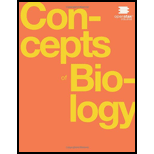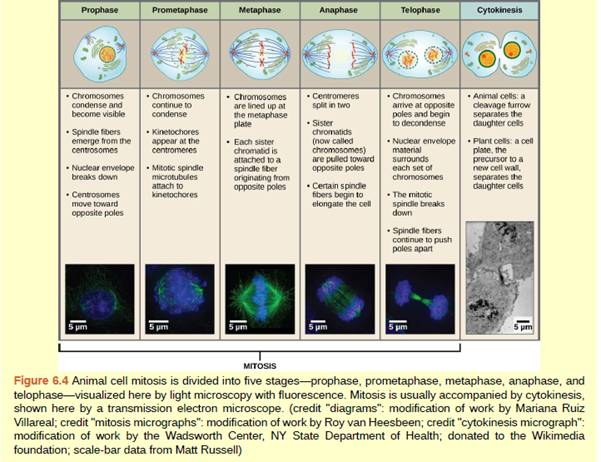
Concept explainers
Figure 6.4 Which of the following is the correct order of events in mitosis?
a. Sister chromatids line up at the metaphase plate. The kinetochore becomes attached to the initotic spindle. The nucleus re-forms and the cell divides. The sister chromatids separate.
b. The kinetochore becomes attached to the mitotic spindle. The sister chromatids separate. Sister chromatids line up at the metaphase plate. The nucleus re-forms and the cell divides.
c. The kinetochore becomes attached to metaphase plate. Sister chromatids line up at the metaphase plate. The kinetochore breaks down and the sister chromatids separate. The nucleus re-forms and the cell divides.
d. The kinetochore becomes attached to the mitotic spindle. Sister chromatids line up at the
metaphase plate. The kinetochore breaks apart and the sister chromatids separate. The nucleus re-forms and the cell divides.

Introduction:
The mitosis is the process of the cell division, which takes place in all the somatic cells present in the body of a multicellular organism. The mitosis is divided into four phases, i.e., prophase, metaphase, anaphase and telophase.
In the prophase stage, the genetic material condenses to form the chromatids. These chromatids get lined up at the equator or the metaphase plate during metaphase and the spindle fibers bind to the kinetochore present at the center of the sister chromatids. In anaphase, the sister chromatids are pulled to the opposite poles, and in telophase, the chromatids are decondensed and nuclear envelope is formed which results in two nuclei in the dividing cell.
Answer to Problem 1ACQ
Correct answer:
The correct answer is option (d) − the kinetochore becomes attached to the mitotic spindle. Sister chromatids line up at the metaphase plate. Cohesin proteins break down and the sister chromatids separate. The nucleus reforms and the cell divides.
Explanation of Solution
Explanation/justification for the correct answer:
Option (d): During early metaphase, the kinetochore attaches to the spindle fibers. The sister chromatids of the dividing cells line up at the metaphase plate. After the alignment, the spindle fibers attach to the kinetochore. The sister chromatids are bound together with the help of cohesin. After the alignment of the sister chromatids at the metaphase plate, the cohesin breaks and the sister chromatid separate and move to the opposite poles. A nucleus is formed on each opposite pole and then the cytoplasmic division results in the formation of two new cells.
Explanation for the incorrect answer:
Option (a): In this option, the separation of sister chromatids is placed after the formation of a nucleus, but the formation of the nucleus takes place after the sister chromatids are separated and move to opposite poles. So, it is an incorrect option.
Option (b): In this option, the separation of the sister chromatids is placed before the lining of sister chromatids on the metaphase plate. The cohesin protein breaks after the sister chromatids are lined up on the metaphase plate, which causes the breaking of sister chromatids. So, it is an incorrect option.
Option (c): In this option, it is said that the kinetochore is attached to the cohesin protein, but the kinetochore actually gets attached to the spindle fibers. So, it is an incorrect answer.
During metaphase, the mitotic spindle binds to the kinetochore and causes the alignment of sister chromatids on metaphase plate and the cohesin breaks which results in separation of the sister chromatids. The sister chromatids are then pulled to the opposite pole, where the new nucleus is formed followed by cytokinesis. In this way the two new cells from one existing cell are formed. Hence, option (d) is the correct answer.
Want to see more full solutions like this?
Chapter 6 Solutions
Concepts of Biology
Additional Science Textbook Solutions
Biology: Life on Earth (11th Edition)
Introductory Chemistry (6th Edition)
Anatomy & Physiology (6th Edition)
Campbell Essential Biology (7th Edition)
Campbell Biology (11th Edition)
Applications and Investigations in Earth Science (9th Edition)
- An urgent care center experienced the average patient admissions shown in the Table below during the weeks from the first week of December through the second week of April. Week Average Daily Admissions 1-Dec 11 2-Dec 14 3-Dec 17 4-Dec 15 1-Jan 12 2-Jan 11 3-Jan 9 4-Jan 9 1-Feb 12 2-Feb 8 3-Feb 13 4-Feb 11 1-Mar 15 2-Mar 17 3-Mar 14 4-Mar 19 5-Mar 13 1-Apr 17 2-Apr 13 Forecast admissions for the periods from the first week of December through the second week of April. Compare the forecast admissions to the actual admissions; What do you conclude?arrow_forwardAnalyze the effectiveness of the a drug treatment program based on the needs of 18-65 year olds who are in need of treatment by critically describing 4 things in the program is doing effectively and 4 things the program needs some improvement.arrow_forwardI have the first half finished... just need the bottom half.arrow_forward
- 13. Practice Calculations: 3 colonies were suspended in the following dilution series and then a viable plate count and microscope count was performed. Calculate IDF's, TDF's and then calculate the CFU/mL in each tube by both methods. Finally calculate the cells in 1 colony by both methods. Show all of your calculations in the space provided on the following pages. 3 colonies 56 cells 10 μL 10 μL 100 μL 500 με m OS A B D 5.0 mL 990 με 990 με 900 με 500 μL EN 2 100 με 100 μL 118 colonies 12 coloniesarrow_forwardDescribe and give a specific example of how successionary stage is related to species diversity?arrow_forwardExplain down bellow what happens to the cell in pictures not in words: Decreased pH in mitochondria Increased ATP Decreased pH in cytosol Increased hydrolysis Decreasing glycogen and triglycerides Increased MAP kinase activity Poor ion transport → For each one:→ What normally happens?→ What is wrong now?→ How does it mess up the cell?arrow_forward
- 1.) Community Diversity: The brown and orange line represent two different plant communities. a. Which color represents the community with a higher species richness? b. Which color represents the community with a higher species evenness? Relative abundance 0.1 0.04 0.001 2 4 6 8 10 12 14 16 18 20 22 24 Rank abundance c. What is the maximum value of the Simpson's diversity index (remember, Simpson's index is D = p², Simpson's diversity index is 1-D)? d. If the Simpson's diversity index equals 1, what does that mean about the number of species and their relative abundance within community being assessed?arrow_forward1.) Community Diversity: The brown and orange line represent two different plant communities. a. Which color represents the community with a higher species richness? b. Which color represents the community with a higher species evenness? Relative abundance 0.1 0.04 0.001 2 4 6 8 10 12 14 16 18 20 22 24 Rank abundance c. What is the maximum value of the Simpson's diversity index (remember, Simpson's index is D = p², Simpson's diversity index is 1-D)? d. If the Simpson's diversity index equals 1, what does that mean about the number of species and their relative abundance within community being assessed?arrow_forwardwhat measures can a mother to take to improve the produce of her to milk to her newborn baby ?arrow_forward
- 1. Color the line that represents all ancestors of the Eastern white pine tree green (but only the ancestral line NOT shared with other organisms) 2. Oncle the last common ancestor of the Colorado blue spruce tree and Eastern white pine tree. 3. Put a box around the last common ancestor of the sugar maple tree and the dogwood tree. 4. Put a triangle around the last common ancestor of the red pine tree and the american holly bush. 5. Color the line that represents all ancestors of the Ponderosa pine tree red (including all shared ancestors). 6. Color the line that represents all ancestors of the American elm tree blue (including all shared ancestors). 7 Color the line that represents all ancestors of the Sabal palm tree purple (including all shared ancestors) 8. Using a yellow highlighter or colored pencil, circle the clade that includes all pine trees. 9. Using a orange highlighter or colored pencil, circle the clade that includes all gymnosperms 10. Can you tell…arrow_forwardYou have been hired as a public relations specialist to give invertebrates a good name. After all, they are much more than just creepy crawly bugs! Your first task though is to convince yourself that is true. The best way to do that is to start close to home. Find something in your house that is a product obtained directly from an invertebrate or only due to an invertebrate’s actions. Describe the product, its function and utility, as well as any human manufactured alternatives. Be sure to highlight the advantages of obtaining this directly from nature. Keep in mind, a product can be something you use, wear, eat, or enjoy for its visual appeal.arrow_forwardUse the following tree diagram to answer Questions #8-10. 8) Which of the following two animals are the most closely related based on the tree to the left? a) Pig and camel b) Hippo and pig c) Deer and cow 9) CIRCLE on the tree diagram where the common ancestor between a hippo and a cow is. 10) Put a SQUARE on the tree diagram where the common ancestor between a pig and a peccary is.arrow_forward
 Biology 2eBiologyISBN:9781947172517Author:Matthew Douglas, Jung Choi, Mary Ann ClarkPublisher:OpenStax
Biology 2eBiologyISBN:9781947172517Author:Matthew Douglas, Jung Choi, Mary Ann ClarkPublisher:OpenStax Concepts of BiologyBiologyISBN:9781938168116Author:Samantha Fowler, Rebecca Roush, James WisePublisher:OpenStax College
Concepts of BiologyBiologyISBN:9781938168116Author:Samantha Fowler, Rebecca Roush, James WisePublisher:OpenStax College
 Human Heredity: Principles and Issues (MindTap Co...BiologyISBN:9781305251052Author:Michael CummingsPublisher:Cengage Learning
Human Heredity: Principles and Issues (MindTap Co...BiologyISBN:9781305251052Author:Michael CummingsPublisher:Cengage Learning Human Biology (MindTap Course List)BiologyISBN:9781305112100Author:Cecie Starr, Beverly McMillanPublisher:Cengage Learning
Human Biology (MindTap Course List)BiologyISBN:9781305112100Author:Cecie Starr, Beverly McMillanPublisher:Cengage Learning





